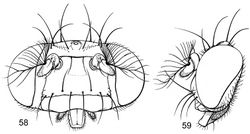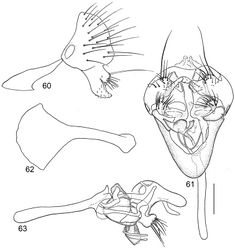Planinasus insulanus
| Notice: | This page is derived from the original publication listed below, whose author(s) should always be credited. Further contributors may edit and improve the content of this page and, consequently, need to be credited as well (see page history). Any assessment of factual correctness requires a careful review of the original article as well as of subsequent contributions.
If you are uncertain whether your planned contribution is correct or not, we suggest that you use the associated discussion page instead of editing the page directly. This page should be cited as follows (rationale):
Citation formats to copy and paste
BibTeX: @article{Mathis2012ZooKeys225, RIS/ Endnote: TY - JOUR Wikipedia/ Citizendium: <ref name="Mathis2012ZooKeys225">{{Citation See also the citation download page at the journal. |
Ordo: Diptera
Familia: Periscelididae
Genus: Planinasus
Name
Planinasus insulanus Mathis & Rung & Kotrba, 2012 sp. n. – Wikispecies link – ZooBank link – Pensoft Profile
Description of male
Small to moderately small flies, body length 1.60–2.80 mm.
Head (58–59): Head ratio 0.52–0.54; frons generally brownish black to black, mostly bare, shiny, except for microtomentose, velvety-appearing, anterolateral angles, latter setulose; frons conspicuously wider than long, frontal ratio 0.34–0.37; interfrontal seta shallowly curved, elongate, length subequal to length of lateral vertical seta. Antenna mostly yellowish orange, especially medially and ventrally; pedicel brown laterally, mostly yellowish medially, dorsum brown; basal flagellomere moderately long, length conspicuously greater than height at base, tapered to moderately acute point at apex, both dorsal and ventral margins curved; pedicel with ventral projection short, not extended anteriorly much beyond dorsal margin, bearing long, ventroapical seta (extended slightly beyond apex of basal flagellomere), 1 dorsomedial seta and 1 medial seta; arista bearing 13–14 dorsal rays, 3–4 ventral rays. Face comparatively wide, facial ratio 0.64–0.68; dorsad of transverse carina moderately microtomentose, appearing subshiny, mostly blackish brown, but antennal grooves yellowish and with silvery white microtomentum immediately dorsal of transverse carina; ventrad of transverse carina densely microtomentose, silvery white, sericeous; large facial setae arranged in a single transverse row of about 8 setae, medial pair of setae approximate, ventroclinate, next seta curved dorsally, lateral 2 setae ventroclinate. Clypeus and palpus brownish black; clypeus with some silvery white microtomentum.
Thorax: Mesonotum generally brownish black to black, sparsely microtomentose, subshiny to shiny; postpronotum brown with some yellowish coloration around margin; area from postpronotum and through notopleuron mostly bare, finely microtomentose, dull; pleural areas finely microtomentose, dull, blackish brown; anepisternum mostly bare but with several setulae dorsally and posteriorly, 3–4 setulae along posterior margin longer than others; katepisternum generally setulose, bearing 2 setae toward dorsal margin. Wing without pattern, generally infumate, slightly more so anteriorly, base hyaline. Coxae and trochanters yellowish brown to brown; femora and tibiae uniformly brownish black; forefemur lacking a preapical annulus; tarsi mostly yellowish, apical 2–3 tarsomeres becoming darker; forefemur bearing 1 seta at apical 1/3 along posteroventral surface.
Abdomen: Uniformly blackish brown, mostly dull to faintly subshiny, moderately invested with microtomentum. Male abdomen: Tergites 1+2–6 well developed, lengths of tergites 3–6 subequal; tergite 7 narrow; sternites 3, 4, 5 generally as rectangular plates, slightly wider than long, lateral margins shallowly arched; sternite 5 rectangular, width twice length, posterior margin with medial notch in sclerotized portion, bearing row of setulae along posterior margin; sternite 6 apparently absent; sternite 7 narrow, band-like, forming an annulus with tergite 7. Male terminalia (Figs 60–63): Epandrium in lateral view (Fig. 60) roughly trapezoidal, higher than wide, narrowed dorsally, anterior margin shallowly emarginate, posterior margin sinuous; surstylus length slightly more than half length of epandrium, extended from posteroventral margin of epandrium in nearly oblique alignment with it, in lateral view (Fig. 60) wide, robustly developed basally, apical half abruptly tapered, forming a sub-basal posterior angle before posteroventral, moderately deep emargination, forming a tapered, pointed shallowly curved apex, bearing an elongate seta at sub-basal angle and numerous setulae along emargination; hypandrium in ventral view (Fig. 61) robustly developed, rounded V-shaped, anterior angle rounded; postgonite in ventral view (Fig. 61) robust, bearing, ovate lobe invested with numerous setulae, in lateral view (Fig. 63) with lobe truncate apically, bearing many long setulae; phallus in ventral view forming complex, convoluted structure with pre- and postgonites, in lateral view (Fig. 63) with narrow, bar-like processes; phallapodeme in lateral and ventral views (Figs 61, 63) elongate, parallel sided, bluntly rounded apically; ejaculatory apodeme in lateral view (Fig. 62) enlarged, length subequal to that of phallapodeme, basal half relatively slender, almost parallel-sided, apical 1/3 greatly expanded, fan-like.
Description of female
As in male except as follows: Head generally narrower, head ratio 0.60–0.62; frontal ratio 0.51–0.54; facial ratio 0.26–0.29.
Type material
The holotype male is labeled “DOMINICAN R[E]p[UBLIC]. LaVega: n[ea]r.Jarabacoa, Salto Guasara, 19°04.4'N, 70°42.1'W, 680m, 9May 1995,Wayne N.Mathis/USNM ENT 00136283 [plastic bar code label]/HOLOTYPE ♂ Planinasus insulanus Mathis & Rung USNM [red].” The holotype is double mounted (minuten pin), is in excellent condition, and is deposited in the USNM. Paratypes are as follows: DOMINICAN REPUBLIC. Barohona: Baoruco (8.3 km S, 18°01.9'N, 71°08.4'W), 15 May 1995, W. N. Mathis (2♀; USNM); La Ciénaga (just S; 18°02.9'N, 71°06.4'W; 30 m; swept near stream), 3 Aug 1991, D. A. Grimaldi, J. Stark (1♂, 4♀; AMNH); Ojeda (17°58.2'N, 71°10.6'W), 22 Mar 1999, W. N. Mathis (6♂, 10♀; USNM); Paraíso (5 km N; 18°01.5'N, 71°11.6'W; 150 m), 21 Mar 1999, W. N. Mathis (4♂, 2♀; USNM); Paraíso (7 km N; 18°03'N, 71°11'W; 200 m), 27 Nov–4 Dec 1991, L. Masner, S. Peck (1♀; DEBU); San Rafael (18°01.9'N, 71°08.4'W), 22 Mar 1999, W. N. Mathis (4♂, 2♀; USNM). El Seibo: El Seibo (5 km E, 18°44.7'N, 68°59.2'W, 120 m), 12 May 1995, W. N. Mathis (1♀; USNM). Independencia: La Descubierta (18°34.1'N, 71°43.8'W), 25 Mar 1999, W. N. Mathis (1♂, 3♀; USNM); Puerto Escondido (18°19.6'N, 71°35'W; 1370 m), 24 Mar 1999, W. N. Mathis (4♂, 7♀; USNM). La Vega: Bonao (21 km W; 18°56.6'N, 70°27'W; 1036 m), 2 Aug 1991, D. A. Grimaldi, J. Stark (6♂, 5♀; AMNH); Jarabacoa (1–2 km S; 19°06.9'N, 70°37'W; 520 m), 8–21 May 1995, 1998, D. and W. N. Mathis (2♀; USNM); Jarabacoa (near), Salto Guasara (near, 19°04.4'N, 70°42.1'W; 680 m), 9 May 1995, W. N. Mathis (1♂; USNM); Jarabacoa (5 km S, 19°04.4'N, 70°36.5'W; 640 m), 8–20 May 1995, W. N. Mathis (1♂, 5♀; USNM). Monte Plata: Bayaguana (9 km N; 18°47'N, 69°38'W; 91 m; on fungus), 8 Aug 1991, D. A. Grimaldi, J. Stark (3♂, 6♀; AMNH). Peravia: San José Ocoa (10 km NE; 18°35'N, 70°25.6'W), 21 May 1998, D. and W. N. Mathis (12♂, 5♀; USNM). Puerto Plata: Sonador (19°35.9'N, 70°36.2'W; 440 m), 18 May 1995, W. N. Mathis (4♂, 2♀; USNM).
Type locality
Dominican Republic. La Vega: near Jarabacoa, Salto Guasara (19°04.4'N, 70°42.1'W, 680 m).
Other specimens examined
CUBA. Cienfuegos: Topes de Collantes (5 km WNW, 21°56.5'N, 80°02.3'W; 600 m), 11 Dec 1994, W. N. Mathis (3♂, 3♀; USNM). Pinar del Rio: Soroa (2 km NW, 22°48.6'N, 83°01.2'W), 4–5 Dec 1995, W. N. Mathis (10♂, 5♀; USNM); Soroa (22°47.7'N, 83°W), 4–6 Dec 1995, W. N. Mathis (2♂, 3♀; USNM). Sancti Spiritus: Topes de Collantes (21°55.2'N, 80°02.3'W; 350 m), 10 Dec 1995, W. N. Mathis (5♂, 4♀; USNM). Santa Clara: San Juan Mountains (20°03'N, 75°41'W), Jan-Feb 1927, C. T. and B. B. Brues (1♂, 1♀; USNM).
JAMAICA. St. Ann: Runaway Bay (18°27.4'N, 77°19.6'W; stream bed), Feb 1969, W. W. Wirth (1♀; USNM). Ocho Rios (18°23.9'N, 77°6.2'W), Jul 1958, W. B. Heed, M. Wasserman (1♂, 1♀; USNM). St. Thomas: near Bath (17°57.9'N, 76°21'W), Feb 1956, W. B. Heed (1♀; USNM).
Distribution
(Fig. 64). Neotropical: West Indies. Cuba (Cienfuegos, Pinar del Rio, Sancti Spiritus, Santa Clara), Dominican Republic (Barahona, El Seibo, Independencia, La Vega, Monte Plata, Peravia, Puerto Plata), Jamaica (St. Ann).
Etymology
The species epithet, insulanus, is of Latin derivation, meaning island and refers to the occurrence of this species on West Indian islands.
Remarks
Variation in wing coloration is particularly evident in specimens of this species and may be related to the age of specimens, older specimens having darker wings, but also to underlying genetic variation. The shape of the surstylus and hypandrium readily distinguish this species from congeners.
Original Description
- Mathis, W; Rung, A; Kotrba, M; 2012: A revision of the genus Planinasus Cresson (Diptera, Periscelididae) ZooKeys, 225: 1-83. doi
Images
|


